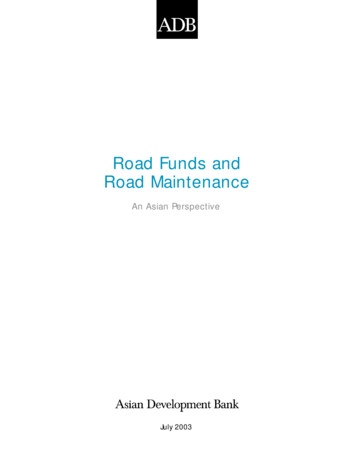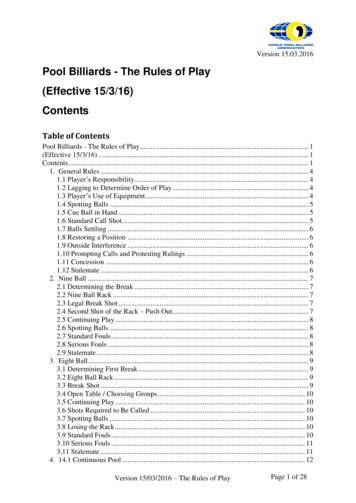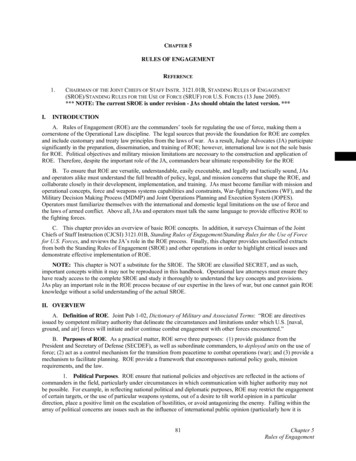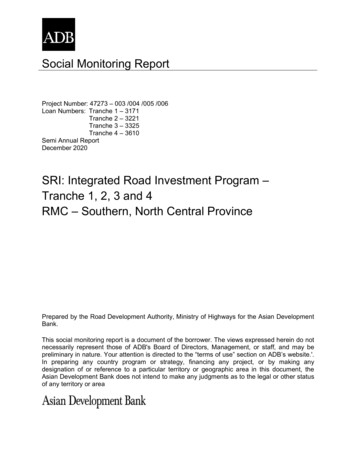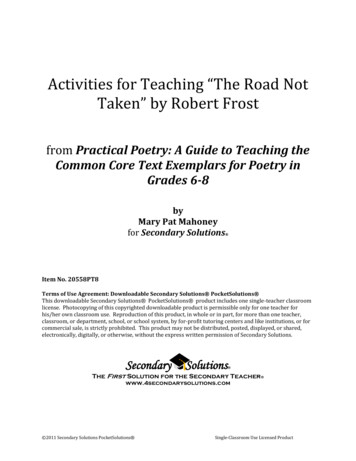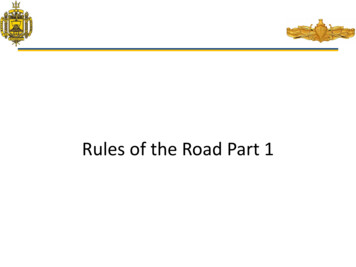
Transcription
Rules of the Road Part 1
History of the Rules Regulations for Preventing Collisions at Sea (COLREGS)– Refers to International Rules ONLY– Full name: Convention on the international Regulations for PreventingCollisions at Sea, 1972– Rules in this form were developed by the IMO, put in effective July 15,1977 and amended in 1981 and 1989 Inland Rules– Inland Navigation Rules Act, 1980– Combined and standardized old sets of Rules– Inland Rules are part of the Code of Federal Regulations: this meansthey are LAW2
The Nature of Risk at Sea In 1979, MIT analyzed collision data with thefollowing results– Crossing 9%, Overtaking 9%, Doubtful 10%, Meeting/HeadOn 72%– 1/3 of collisions occur at night or early morning (4-8 watch)– Visibility was the number one factor influencing collision3
Construction of the Book Five Parts– Part A: General– Part B: Steering and Sailing Rules Three Subparts– Part C: Lights and Shapes– Part D: Sound and Light Signals– Part E: Exemptions (Not testable) Five Annexes4
Construction of the Book Other information–––––––Interpretive RulesLines of Demarcation (where else can they be found?)Penalty Provisions (Inland)Alternative ComplianceWaters Specified by the SecretaryVessel BTB R/T RegulationsCorrections “ there is simply no substitute for studying and reading therules of the road directly from the Coast Guard text”– ADM James Stavridis5
Part AGeneral
Rule 1ApplicationInternational Applies to ALL vessels uponthe high seas Rules do not interfere withnational sovereignty– Operation of special rules– Must comply as closely aspossible with COLREGS– Traffic Separation Schemes– Governments approve“closest possible compliance”Inland Applies to all vessels uponthe inland waters of US– Constitute “special rules” asreferred to in COLREGS– These must not interfere withspecial rules made by SECNAV– Traffic Separation Schemesmay be established– “The Secretary” approves allcertificates of alternativecompliance7
Rule 1ApplicationSpecial Navy Signals (Title 32 – National Defense) Submarines Special operations Man Overboard Convoy Yardarm signaling lights Wake illumination A/C Warning Flight ops UNREP contour Amphibious ops Minesweeping stationkeeping
Rule 2Responsibility “Nothing in these Rules shall exonerate any vessel, orthe owner, master or crew thereof, from theconsequences of any neglect to comply with theseRules or of the neglect of any precaution which maybe required by the ordinary practice of seaman” The General Prudential Rule– Forehandedness and prudence– The mariner is responsible not only for complying with theRules but also for avoiding a collision.9
Rule 3Definitions Basics––––––Sailing vesselPower-driven vessel (includes non-displacement)VesselUnderwayIn sight of one anotherRestricted Visibility: normal range of visibility for a given height of eyeis reduced10
W.I.G.11
Rule 3Definitions Vessel engaged in fishing– Using “nets, lines, trawls or other fishing apparatuswhich restrict maneuverability”– Be careful with “restricts maneuverability” becauseit is NOT “restricted in ability to maneuver”– Does not include a vessel engaged in trollingTrollingTrawling12
Rule 3Definitions Vessel not under command––––Unable to maneuver as required by the RulesUnable to keep out of the way of another vesselWhat are “exceptional circumstances?”Loss of main engines; Damaged shaft; Major internaldamage; etc.13
Rule 3Definitions Vessel restricted in her ability tomaneuver– FROM THE NATURE OF HER WORK isrestricted in her ability to maneuveras required by these Rules– Unable to keep out of the way ofanother vessel– Includes towing ONLY if severelyrestricted in ability to deviate fromtheir course14
Rule 3Definitions Constrained by draft– International only– Draft in relation to the available depth and width ofnavigable water– No inland equivalent because “such a subjectiverule might lead to abuses and result in a situationwherein a vessel considering herself constrained byher draft claims a right of way to which she is notentitled thereby creating a dangerous situation” Farewll15
Rule 3Definitions Additional Inland terms––––––Western RiversGreat LakesSecretaryInland Waters“Inland Rules” or “Rules”International Regulations16
Part BSteering and Sailing RulesSubpart I – Conduct of Vessels in AnyCondition of Visibility
Rule 4Application Application of Rules 4-10– Any condition of visibility18
Rule 5Look-out Maintain a proper lookout by all availablemeans underway AND at anchor– Sight and hearing– Designated comms watch to enable listening inrestricted visibility– Bearing circles, alidades and night vision Is your look-out maintaining a properwatch in foul weather?– Support your lookout with foul weather andcold weather gear Must be trained to “make a full appraisalof the situation ”19
Rule 6Safe Speed Determinants of Safe Speed––––––Draft of vessel in relation to charted depthStopping distance and turning abilityPresence of background lightingState of winds, sea, and currentState of visibilityTraffic density “Fast enough to maneuver,slow enough to stop in time”20
Rule 6Safe Speed Vessels with operational radar should alsoconsider:– Characteristics, efficiency and limitations of theradar set– Constraints imposed by range scale in use– Effect on radar of sea state, weather or otherinterference– Possibility that small vessels, objects, or ice maynot be detected by radar at an adequate range toavoid collision– Number, location, and movement of vesselsdetected Must reassess as conditions change!21
Rule 7Risk of Collision Every vessel shall use all available meansappropriate to the prevailing circumstances todetermine if risk of collision exists– Early use of RADAR or equivalent systematic observation ofdetected objects MOBOARDS!– Systematic observation DO NOT make assumptions on scanty information– Corroborate sources of data CBDR risk of collision Assume risk of collision exists if not sure22
Rule 8Action to Avoid Collision Any action taken to avoid collision :– Shall be positive, made in ample time, and withdue regard to the observance of goodseamanship– Should be large enough to be readily apparentto the other vessel– Avoid small alterations of course and speed.– Given ample sea room, course change alone ismost effective The effectiveness of the action shall becarefully checked until the vessel is passedand clear23
Rule 8Action to Avoid Collision There’s only two variables you canalter to avoid collision: course andspeed If necessary, slacken speed to allowmore time to analyze the situation oravoid collision Even if you are the stand on vessel,you still must take action to AVOIDCOLLISION24
Rule 8Action to Avoid Collision A vessel required by any rule in this part not to impedeanother vessel’s passage SHALL take early action If you must not impede a vessel, you must be fully aware ofthe action required by your vessel under the Rules If you are the stand-on vessel, you are still responsible forpreventing collision25
Rule 9Narrow Channels The basics– Stay on the “right” side of the channel– Sailing vessels, fishing vessels, and vessels less than 20 meters shallnot impede vessels restricted to the channel Crossing vessels shall not impede vessels which can onlysafely operate in the channel If the circumstances of the case admit do not anchor in achannel26
Rule 9Narrow Channels Rule 9 (e) i (International)– Signals SHALL be sounded“when overtaking can takeplace only if the vessel to beovertaken has to take actionto permit safe passing” Rule 9 (e) i (Inland)– Signals SHALL be exchangedfor all overtaking situations Danger signal required if any doubt exists ( )– This signal is used before a vessel is in extremis so confusion can beresolved Signal and response when approaching a bend (‒)27
Rule 10Traffic Separation Schemes The basics– Use small angle of approach toenter/depart– Cross the scheme at right angles– Only proceed in the correct lane– If possible, do not proceed in the separationzone or use inshore traffic zone exceptentering or leaving the TSS– Do NOT proceed in the wrong direction– If not using the TSS avoid it by as much aspossibleEnteringCrossing28
Rule 10Traffic Separation Schemes Applies to traffic separation schemes adopted by IMO. Doesnot relieve any vessel of her obligation under any other rule.– TSS is just paint on the chart (different than a narrow channel)– Normal rules to determine stand-on and give-way apply29
Rule 10Traffic Separation Schemes Sailing vessels, fishing vessels, vessels less than 20 metersshall not impede the safe passage of a power-driven vesselfollowing a traffic lane– May use inshore traffic zoneDo not impede passage30
Rule 10Traffic Separation Schemes Exceptions to the Rule to extent necessary to carry out theirwork– R.A.M. when engaged in an operation for the maintenance of safety ofnavigation in a TSS– R.A.M. when engaged in an operation for the laying, servicing, orpicking up of a submarine cable31
Rules of the RoadScenario 1ARPA: Relative North-up6 mile scaleOwnOwn shipTarget1Stand- on12Alter to Stbd23Alter to Port34Slow Down45Stop5Relative Vectors12 minutes(red tails)32
Part BSteering and Sailing RulesSection II – Conduct of Vessels inSight of One Another
Rule 11 & Rule 12Application Rule 11– These Rules apply to vessels in sight of one another Rule 12– Port tack yields to starboard tack– Windward yields to leeward vessel on same tackStarboardTackWindLeewardWindPort TackWindward34
Rule 13Overtaking Must be approaching from two points (22.5 ) abaft the beamto be overtaking At night this means the overtaking vessel can only see thestern light of the vessel being overtaken.– Will also see all around lights and towing lights if they are required bythe vessel being overtakenOvertaking35
Rule 13Overtaking Any vessel overtaking any other vessel SHALL keep out of theway of the vessel they are overtaking– What does it mean when the Rules state “notwithstanding anythingcontained in Rules 4-18 ” Other Rules may prevail, for example narrow channels, TSS When in doubt assume you are overtaking. DO NOT assumeyou are overtaken why? Once an overtaking situation, always an overtaking situationuntil overtaking vessel is past and clear36
Rule 14Head-on Situation Two power-driven vessels, reciprocal or near reciprocalcourses, risk of collision– Rule of thumb for defining “nearly reciprocal” 6 off your vessel’scourse when the contact’s relative bearing is 6 off the bow At night, masthead lights in a line, or nearly so, and both sidelights. During the day the corresponding aspect DO NOT assume a crossing situation if in doubt, but alwaysassume head-on– Dual action rule37
Rule 15Crossing Situation Must be two power-driven vessels, crossing (not head-on orovertaking), and involve risk of collision The vessel which has on her starboard side another vesselcrossing must give-way As the give-way vessel, avoid crossing the bow whenmaneuvering to avoid collision38
Rule 16Action by Give-way Vessel So far as possible take EARLY and SUBSTANTIAL action tokeep well clear– May not be able to maneuver immediately– Don’t drive yourself into another collision or aground– Show a distinct change in aspect39
Click 17Action by Stand-on Vessel Maintain course and speed MAY change course and speed when it is apparent the giveway is not taking action– Hull down is not “within sight” as that vessel can not see you and youprobably have a poor perspective on target angle– When you do take action, AVOID whenever possible turning to port fora vessel on your port side SHALL take action when everything the give-way vessel canpossibly do is not enough to avoid collision– You are already in extremis! Do something NOW!40
Rule 18Responsibilities Between Vessels NAVRulesCanFrustrateSomePeopleSayWhat?! N.U.CR.A.M.C.B.DFishingSailingPower-drivenSea PlaneW.I.G. NewReelsCatchFishSoPurchaseSomeWeekly Rules 9, 10, and 13 are exceptions to this Rule41
Part BSteering and Sailing RulesSection III – Conduct of Vessels in (ornear) Restricted Visibility
Rule 19Conduct of Vessels in Restricted Visibility Applies to vessels NOT in sight of each other IN OR NEARrestricted visibility At all times:– Proceed at safe speed “adapted to the prevailing circumstances andconditions of restricted visibility”– Power-driven will have engines ready to maneuver– Reassess how we comply with Rules 4-10. Adapt to the prevailingcircumstances!43
Rule 19Conduct of Vessels in Restricted Visibility Detecting a vessel by RADAR alone– Determine if a close quarters situation isdeveloping and if risk of collision exists– Take avoiding action in ample time (if risk ofcollision)– When taking avoiding action DO NOT: Turn port for a vessel forward of your beamexcept overtaken vessels Turn toward a vessel on or abaft your beam(turning port here may be ok!)44
Rule 19Conduct of Vessels in Restricted Visibility Detecting a fog signal forward of the beam or can not avoidclose quarters with a vessel forward of the beam– Reduce speed to bare steerageway– If needed, take all way off. What is disadvantageous about this?– ALWAYS navigate with extreme caution45
Rules of the Road Part 2
Enabling Objectives Know the U.S. Inland Rules of the Road and theInternational Regulations for preventing collision at sea
Part CLights and Shapes
Rule 20Application These Rules shall be complied with inALL weathers Rules concerning lights shall becomplied with– From sunset to sunrise– From sunrise to sunset during restrictedvisibility– MAY be displayed in all other circumstances Any additional lights– Cannot be mistaken for lights specified inthese rules– Must not obscure the lights in the Rules– Must not interfere with a proper lookout49
Rule 20Application Day shapes shall be displayed from sunrise until sunset Purpose of Lights and Day shapes:– Helps determine stand on/give way status– Indicates the occupation of certain vessels– Aids in the determination of target angle and course50
Rule 21Definitions Masthead light– Inland: vessels less than 12m as close to centerline as possible Side lights– Both: vessels less than 20m can combine– Inland: vessels less than 12m as close to centerline as possible51
Rule 21Definitions Sternlight– White, 135 arc centered on the stern Towing light– Yellow, 135 arc centered on the stern All Around light– Any color, 360 Flashing light– Any color, 120 fpm or more Special Flashing light (Inland Only)– Yellow, 50-70 fpm, as far forward as possible, 180 -225 arc centeredon the bow52
Rule 22Visibility of Lights The following are MINIMUM luminous ranges for lightsTYPECOLORMastheadwhiteSidelight variousARC2253 nm135135360 50m6 nm2 nm3 nm3 nm3 nm12-50m5 nm1 nm2 nm2 nm2 nm 12m2 nm2 nm2 nm2 nm Special flashing light – 2 nm White, all-round light on inconspicuous, partly submergedobject – 3 nm53
Rule 23Power-Driven Vessels Underway A power-driven vessel underway– Masthead light forward;– Second masthead light abaft of and higher thanthe forward one; vessel of less than 50 meters inlength shall not be obliged to exhibit such lightbut may do so– Sidelights– Sternlight This configuration used while making wayAND not making way54
Rule 23Power-Driven Vessels Air-cushion vessel operating in the nondisplacement mode exhibits an allround flashing yellow light (otherwisenormal power-driven lights)55
Rule 23Power-Driven Vessels (International Only) W.I.G. – When takingoff, landing and in flight near the surface,add a high intensity, all-round flashing redlight Vessel 12m may exhibit an all-roundwhite light and side lights– May be displaced from centerline but must stillbe in line with each other and side lights mustbe combined (International only) Vessel 7m whichdoes not go faster than 7 kts may displayan all-round white light56
Rule 24Towing and Pushing Only three groups of towing configurations– Composite Unit– Towing astern (same for International andInland)– Towing Alongside / Pushing Ahead Composite Units– Rigidly connected composite units are treatedas a single power driven vessel (applies tosound signals as well)– (Interpretive rules) Does not include vesselsconnected by lines, hawsers, wires or chains57
Rule 24Towing and Pushing Towing Astern– Four masthead light configurations dependent on size of the vesseltowing and length of the tow– Towing vessel 50m must display headlights IAW Rule 23 (a)(ii) and,for inland, 23 (a)(i)– Tow 200 m: Two masthead lights in vertical line– Tow 200 m: Three masthead lights in vertical line and diamond dayshape (also on towed vessel)Towing vessel 50m, tow 200m58
Rule 24Towing and Pushing Towing Astern (cont’d)– All ships towing display a yellow towing light in a vertical line abovethe stern light– Object being towed will display stern light and side lightsVessel being towedTowing vessel 50m, tow 200mTowing vessel 50m, tow 200mTowing vessel 50m, tow 200m59
Rule 24Towing and Pushing Pushing Ahead / Alongside– Two masthead lights in vertical line for ALL cases– (Inland) Two towing lights at the stern and a special flashing light onthe object being towed/pushed– Object being towed/pushed also displays side lights and, for alongsidea sternlightInternationalInland60
Rule 24Towing and Pushing Partially submerged object being towed shall display:– One all-round white light at the aft end and one at the forwardend (except a dracone)– Diamond shape at or near the end (if 200m tow, diamond alsoat the front INTERNATIONAL)– Additional lights shall be used so that the distance between anytwo lights is not greater than 100m.– International: If the object is greater than 25m wide, twoadditional all-round white lights shall be used to mark theextremities (total of four white lights)– Inland: 25m wide, four all-round white lights to mark its lengthand breadth61
Rule 24Towing and Pushing International Only: Dracones are the exception to the Rule– Only one white light and one diamond on the stern is required62
ATP-1 Volume 1Considerations for Naval Operations Vessels hold right of way depending on their operations The following are listed in order of precedence––––––Helo with SONAR in the water (at the dip)Mine Countermeasure Units including helosShips engaged in underway replenishmentLaunching or recovering amphibious craftLaunching or recovering aircraftDeploying or recovering towed arrays63
Rule 25Sailing Vessels Lights and Shape– Sidelight and a sternlight– Sailing vessels less than 20m in length maycombine the lights into one lantern carriedwhere it can best be seen– A vessel proceeding under sail when also beingpropelled by machinery shall exhibit forwardwhere it can best be seen a conical shape, apexdownward64
Rule 25Sailing Vessels Lights– A sailing vessel may also show anall-round red light over an allround green light in a vertical linenear the top of the mast. Theselights may not be shown inconjunction with a combinationlantern.– “Red over green, sailingmachine.”65
Rule 25Sailing Vessels Sailing vessels less than 7m and vessels under oarsSHALL have an “electric torch or lighted lantern” tobe exhibited in time to prevent collision66
Rule 26Fishing Vessels Fishing underway or at anchor, shallexhibit only the lights and shapesprescribed in this Rule (no anchor lights) Vessels engaged in trawling– A Green all-round light over a white all-roundlight– If 50m, a masthead light abaft and higherthan the all-round green light– When making way sidelights and sternlight– Dayshape – two cones in vertical alignmentwith their apexes togetherTrawling 50mTrawling 50m67
Rule 26Fishing Vessels Vessels engaged in fishing other than trawling– Red light over a white light– If outlying gear extends more than 150m horizontally from the vessel,a white all-round light or cone apex upward in the direction of thegear– NO masthead lights68
Rule 27Vessels Not Under Command Red all-round light over ared all-round light Sternlight and sidelightsONLY when making way Dayshape – two balls in avertical line NO masthead lights69
Rule 27Vessels Restricted in their Ability to Maneuver A vessel restricted in her ability tomaneuver, besides one engaged inmine clearance ops– Red over white over red all-round lights– Sternlight, masthead light or lights,sidelights and sternlight when making way– Those lights or dayshapes prescribed inRule 30 if anchored Dayshape – Ball over diamond overball70
Rule 27Vessels Restricted in their Ability to Maneuver If also engaged in towing, the vessel shall exhibit those lightsrequired by Rule 24– Only applies to towing astern for InternationalTowing while RAM“Severely restricts their ability to deviate from theircourse.”71
Rule 27Vessel Restricted in Ability to Maneuver Dredging or underwater operations (includes divers)– Two all-round red lights or balls to indicated the side on which theobstruction exists– Two all-round green lights or diamonds on the side which anothervessel may pass– When at anchor, these shapes instead of those prescribed in rule 3072
Rule 27Vessels Restricted in their Ability to Maneuver Small vessel engaged in diving operations shall exhibit:– Red over white over red all-round lights– Rigid replica of International Code Flag “A” not less than 1 meter inheight (at night as well)73
Rule 27Vessels Restricted in their Ability to Maneuver A vessel engaged in mine clearance ops shall exhibit– The lights prescribed for a power driven vessel or a vessel at anchor– Three all-round green lights or balls one at the foremast head, one oneach yardarm– This indicates that it is dangerous to approach within 1000 meters74
Rule 28Vessels Constrained by Draft A vessel constrained in her draft may, in addition to the lightsprescribed for a power driven vessel (Rule 23), exhibit:– Three all-round red lights in a vertical line– A cylinder75
Rule 29Pilot Vessel White all round light over a red all round light When underway, sidelights and sternlight If anchored additionally those lights prescribed in Rule 3076
Rule 30Anchored and Aground Vessels A vessel at anchor shall exhibit:– An all-round white light or ball in the fore part– An all-round white light at or near the stern lower than the light in thefore part– Vessel of 50m may exhibit an all-round white light– A vessel 100m in length shall use available lights to illuminate herdecks77
Rule 30Anchored and Aground Vessels A vessel aground (combine NUCand anchored)– Two all-round red lights in a verticalline– Three balls in a vertical line– An all-round white light or ball inthe fore part– An all-round white light at or nearthe stern lower than the light in thefore part– Vessel of 50m may exhibit a singleall-round white light78
Rule 31Seaplanes If a seaplane or a WIG craft cannot exhibit lights andshapes of the characteristics or in the positionsprescribed in this Part, she SHALL display lights andshapes as closely as possible.79
Part DSound and Light Signals
Rule 32Definitions Know the basics–––––WhistleBellGongShort blastProlonged blast81
Rule 33Equipment for Sound Signals Vessel 12 meters shall have a whistle Vessel 20 meters shall have whistle and bell Inland: Vessels 12 meters shall have a whistle and bell (novessel with whistle only) Vessel 100 meters shall have whistle, bell and gong82
Rule 34Maneuvering and Warning SignalsInternationalInland Only 3 signals of action ( ) “I am altering course tostarboard” ( ) “I am altering course toport” ( ) “I am operating asternpropulsion” Only 1 signal of action ( ) “I am operating asternpropulsion” Require agreement by bothpower-driven vessels crossingor meeting within ½ mile ( ) “I intend to leave you onmy port side” ( ) “I intend to leave you onmy starboard side” SHALL use danger signal ifthere is any doubt83
Rule 34Maneuvering and Warning SignalsSupplementary Light SignalInternationalInland Light must be all-round,white and visible for 5 miles ( ) “I am altering course tostarboard” ( ) “I am altering courseto port” ( ) “I am operatingastern propulsion” Light must be all-round,white or yellow, visible for 2miles and synched with thewhistle ( ) “I intend to leave youon my port side” ( ) “I intend to leave youon my starboard side” ( ) “I am operatingastern propulsion”84
Rule 34Maneuvering and Warning SignalsWhen in Sight and OvertakingInternationalInland Must be in a narrowchannel, Rule 9 e (i) (‒ ‒ ) “I intend to overtakeyou on your starboard side” (‒ ‒ ) “I intend to overtakeyou on your port side” (‒ ‒ ) “I agree” SHALL use danger signal ifthere is any doubt ( ) “I intend to overtake youon your starboard side” ( ) “I intend to overtakeyou on your port side” Vessel being overtaken willrepeat the signal to soundagreement SHALL use danger signal ifthere is any doubt85
Rule 34Maneuvering and Warning Signals (‒) Vessels nearing a bend or other area where a vessel maybe obscured to signal her presence– Vessels on other side of obstruction respond with the same signal– Must still arrange passage if required once in sight of one another (Inland Only) (‒) When leaving a dock or berth86
Rule 34Maneuvering and Warning Signals (Inland Only) Bridge-to-Bridgepassage agreement– Agreement may be reached by BTBrather than sound signals. If thisfails, the vessels SHALL sound signals– Refer to page 208, Bridge-to-BridgeRadiotelephone Regulations, 33 CFR2687
Rule 35Sound Signals in Restricted VisibilityTwo Minute Signals (‒) Power-driven vessel making way (‒ ‒) Power-driven vessel NOT making way (‒ ) NUC, RAM, CBD, sailing, fishing, towing (all exceptcomposite)– RAM, fishing also sound this signal at anchor (‒ ) Manned tow (last tow if more than one)– Sounded immediately after (‒ ) on towing vessel Pilot combinations– (‒ ) Pilot vessel making way– (‒ ‒ )Pilot vessel not making way88
Rule 35Sound Signals in Restricted VisibilityOne Minute Signals Vessels at anchor– Vessels 100 meters (5 sec bell)– Vessels 100 meters (5 sec bell), (5 sec gong) Vessels aground– Vessels 100 meters ***(5 sec bell)***– Vessels 100 meters ***(5 sec bell)***, (5 sec gong) Pilot combinations– (5 sec bell ) Pilot vessel 100 meters anchored– (5 sec bell, 5 sec gong, )Pilot vessel 100 meters, anchored89
Rule 36Signals to Attract Attention Sound or light signals that cannot be mistaken for any signalauthorized in the Rules Cannot be mistaken for a navigation aid Strobe lights and high intensity intermittent or revolving lightsSHALL be avoided This is NOT the danger signal or a distress signal90
Rule 37Distress SignalsInternational and InlandInland Only In addition, a high-intensitywhite light 50-70 fpm91
Rule 38Exemptions Used primarily to give vessels ample time to comply with theRules regarding installation and repositioning of lights andsound signal devices92
Annexes Annex I– Positioning and Technical Details of Lights and Shapes– USN vessels do not comply with these specifications Annex II– Additional Signals for Trawling Vessels 20m using pelagic or demersalgear fishing in close proximity When shooting nets shall (may – Inland) display two white lights in avertical line When hauling nets shall (may – Inland) display a white light over a redlight in a vertical line When nets have come fast on an obstruction shall (may – Inland) displaytwo red lights in a vertical line93
Annexes Annex II (cont’d)– Additional Signals for fishing vessels using purse seining gear mayexhibit two yellow lights in a vertical line.– Good to review before transiting popular fishing grounds– Signals for Trawlers– Signals for Purse Seiners Annex III– Technical Details of Sound Signal Appliances94
Annexes Annex IV– Distress Signals– 33 CFR 87 for Inland Rules Annex V–––––Pilot Rules (Inland Only)Law Enforcement Vessels: flashing blue lightPublic Safety Activities: alternately flashing red and yellow lightMoored bargesDredge pipelines: Yellow, 360 , flashing 50-70 times per minute every 10 meters apart, 1-3.5 meters above the water. ALSO, two red lightsat the ends.95
Questions96
–Stay on the “right” side of the channel –Sailing vessels, fishing vessels, and vessels less than 20 meters shall not impede vessels restricted to the channel Crossing vessels shall not impede vessels which can only safely operate in the channel If the circ


